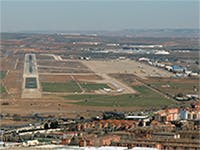Madrid’s Torrejon Airport closed to private aviation traffic
Flight Operations Update – Algy Trotter

As of today – 1st February, Madrid Torrejon, long-time the preferred airport for private jets, is closing its doors to all commercial and general aviation traffic.
All private aircraft traffic will now need to use Madrid’s main airport, Barajas, in a move that PrivateFly sees as a telling sign of Spain’s difficult aviation future.
The key points of the move are:
Private Jet Terminal/FBO
Barajas does not yet have a dedicated private jet terminal, compared to the 6 available at Torrejon.
The former “state pavilion” (the terminal for heads of state etc) is currently being converted into a new General Aviation Terminal (GAT) that will house multiple aircraft handlers. This is due to open in mid-March if all goes according to plan.
In the meantime all private jet passengers will have to use the main terminal to reach their aircraft, passing through a dedicated security lane and transferring to the apron.
For the foreseeable future, there will be no private vehicle access to the ramp, so all passengers will invariably need to pass through a terminal to board aircraft.
Slots/Capacity
Unlike Torrejon, Madrid Barajas is open 24hrs, which provides a significant advantage. It also has 4 very large runways which means that at this point, it has a great deal of spare capacity.
However the down side of this is that all arrivals into Barajas will require individually allocated air traffic control slots, which must be confirmed in advance. This will make flight time changes slightly more difficult than when flying into Torrejon.
Aircraft parking and space
Barajas is one of the largest airports in the world by total size. There is a huge amount of space available for parking private jets of all sizes. However, it has been confirmed that the parking charges at Barajas, which have always been significantly higher than at Torrejon, will not be changing in the
immediate future.
Other issues to consider
Until the general aviation terminal is completed in March, all customs will need to be completed in the main terminal by airport security staff. When the general aviation terminal is completed, customs procedures will revert to similar status as at Torrejon, with dedicated customs officers.
Barajas does have 2 advantages over Torrejon. Firstly, it is closer to Madrid’s city centre than Torrejon and is better connected and sign-posted. Secondly, Barajas airport’s operators are civilian and commercially-motivated (unlike the military airport operators at Torrejon) which means they will strive to increase business from private jets by making handling processes simpler.
PrivateFly waits to see whether the transition from Torrejon to Barajas goes without issues. Many local handling companies have already completed the switch and are reporting few issues generally.
– ALGY TROTTER, OPERATIONS MANAGER –
Related content

Increase in private aviation slots proposed for RAF Northolt

Closest Airports to Conception Earth Quake Disaster Zone



